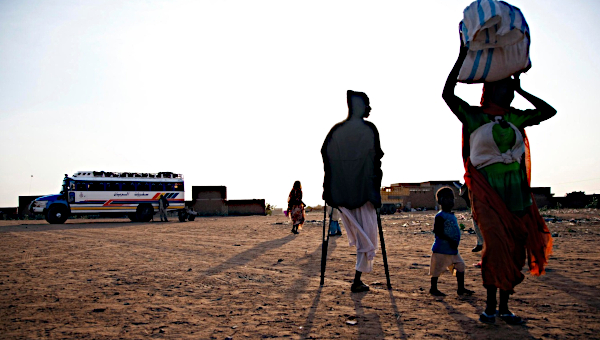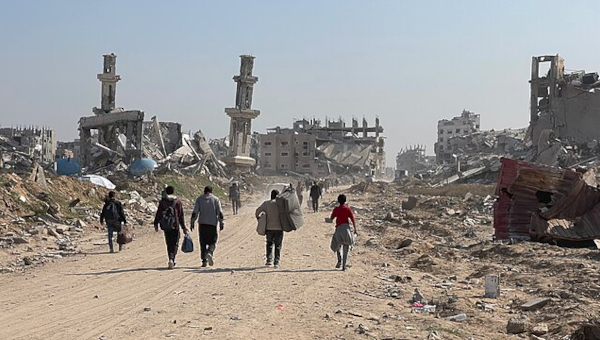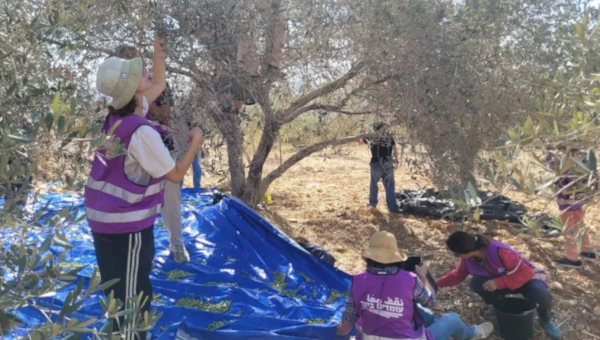Timetable Abandoned: U.S. And NATO To Wage Endless War In Afghanistan
The mainstream news media and alternative sources alike have seized on a recent revelation – though it is hardly such – published by McClatchy Newspapers that “The Obama administration has decided to begin publicly walking away from what it once touted as key deadlines in the war in Afghanistan in an effort to remove emphasis from Barack Obama’s pledge that he would begin withdrawing U.S. forces in July 2011.” An article in this series of over a month earlier, “U.S. And NATO To Wage War 15-Year War In Afghanistan And Pakistan,” documented that much and more, and any attentive reader of news on the internet during the preceding weeks would not have been surprised by the McClatchy feature.
On October 25 Edmund Whiteside, North Atlantic Treaty Organization (NATO) Council Secretary, spoke at Concordia University in Montreal, Canada, and according to the local press said, “Expect the war in Afghanistan” the longest military engagement in both Canadian and American history “to continue for a ‘very long’ time.” In his exact words “Afghanistan will be a very long military venture.”
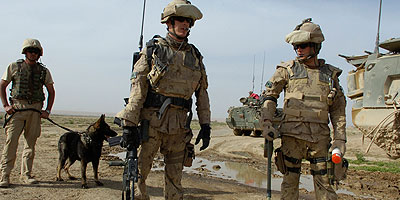
His position will be confirmed at the NATO summit in Lisbon, Portugal this month, as will a major commitment demanded by the U.S.-dominated military bloc’s new Strategic Concept to be adopted at the meeting: the retention of nuclear arms in NATO’s arsenal and the continued stationing of American nuclear bombs in Europe. Whiteside also argued: “Canada says that it doesn’t need ballistic missiles. But Canada is part of a nuclear policy alliance. There’s no getting around that….”
On November 8, the day before the McClatchy article appeared, the spokesman for the 152,000-troop, 50-nation, NATO-led International Security Assistance Force in Afghanistan, German Brigadier-General Josef Blotz, stated that “no timetable has been set for withdrawal of coalition troops from Afghanistan.”
Blotz confirmed that “There has been no timetable yet.”
In regard to transferring security control to Afghan forces, he said, “We will not [proceed] according to a fixed timetable, it will be carried out based on conditions to be achieved over the next couple of years.”[1]
Canada to Stay in Afghanistan
On November 11, Prime Minister Stephen Harper of Canada spoke on the sidelines of the G20 summit in Seoul, South Korea and said that “he’s decided…to keep troops in Afghanistan in a noncombat training role after Canada’s combat mission ends in 2011.” Associated Press cited a senior Canadian government official verifying that Canada “will keep 750 military trainers and 250 support staff in Afghanistan until 2014….”[2]
A similarly bleak perspective on any withdrawal – or beginning of one – next year was offered on the preceding day by the commander of British forces in southern Afghanistan, Major General Nick Carter, who “gave a devastating assessment of the war effort in Afghanistan.” Carter admitted that “In my tour I lost 302 soldiers. Most of them American. The cost in blood and treasure has been enormous.” He added that NATO wouldn’t know if it was winning – whatever that word signifies in a war already in its tenth year and escalating to new heights by the day – until June of 2011, “when the fighting season begins again” and the Atlantic Alliance and the Pentagon can “compare Taliban attacks with this year.”[3]
The U.S. and NATO – the distinction is merely formal as recent estimates are that 140,000 of the 150,000 foreign troops in Afghanistan now serve under NATO command – have lost 633 troops in the war as of November 11. That compares to 521 for all of last year and 295 in 2008. 1,184 of the total 2,203 Western military deaths in the country have occurred in the past 22 months.
Citing U.S. Air Force statistics, an ABC News report of November 10, “Number of Afghan Air Strikes Highest Ever,” disclosed that the amount of air strikes conducted in Afghanistan in October – approximately 1,000 – was the highest monthly total in the war that began in 2001, up from 700 the previous month, which itself marked a 172 per cent increase over September of 2009. The article also detailed that the amount of American and NATO combat sorties so far this year, 26,948, exceeds the previous high of 26,474 from last year.
War Spills Over Into Pakistan
Across the border in Pakistan, the U.S. has launched at least 20 drone missile attacks that have killed 130 or more people since the beginning of last month. A violation of Pakistani airspace by a NATO helicopter gunship in the Federally Administered Tribal Areas occurred on November 2 for at least the fifth time since September, with one killing three Pakistani soldiers on the last day of the latter month.
Earlier this month opposition parliamentarians in Pakistan “expressed serious concern over the violation of Pakistani airspace by North Atlantic Territory Organization (NATO) forces” and “staged a walkout from [a] Senate session in protest and strongly condemned the airspace violations by NATO forces.”[4]
According to a feature in India’s Frontline magazine, “President Obama has substantially increased defence spending and has expanded the war in Afghanistan,” and
“the Obama administration has wholeheartedly endorsed the Bush administration’s policy of eliminating terror suspects using pilotless high-tech drone aircraft.
“Instead of using the laborious technique of capturing alleged terrorists from their hideouts in crowded cities and remote villages, the drones just bomb the house or village where the suspects are holed up. In the process, there has been huge collateral damage. Innocent civilians killed far outnumber those killed in the fight against the occupation.
“Ever since he took office two years ago, Obama has made the deadly drones a key instrument in his fight against the militants in Afghanistan and Pakistan. The drones are also being used liberally to target militants in Yemen and Somalia.”
Ten Years of War
The Afghan war in its tenth year has expanded into a far broader conflict, one which grows in both scope and lethality with each passing week and will escalate yet further before it begins to wind down, if it ever does.
President Obama’s pledge last year to “draw down” U.S. and NATO combat forces from South and Central Asia – they are also stationed in Kyrgyzstan, Tajikistan and Uzbekistan – next year is now revealed to be the transparent political manipulation it was from the start.
A piece by Stephen M. Walt was published on the website of National Public Radio on November 11, entitled “Foreign Policy: Bait And Switch In Afghanistan.” Walt is a professor of international affairs at Harvard University’s John F. Kennedy School of Government, serves on the editorial boards of Foreign Policy, Security Studies, International Relations, and the Journal of Cold War Studies, and is the co-author of The Israel Lobby and U.S. Foreign Policy with John Mearsheimer. He wondered at the chorus of surprise, genuine or feigned, that has greeted the McClatchy article, stating:
“I don’t know anyone who thought the U.S. could turn things around in 18 months, and that particular deadline was little more than a piece of political sleight-of-hand designed to make escalation look like a temporary step. Reasonable people can disagree about whether Obama’s decision to escalate in Afghanistan was the right one (I think it wasn’t), but Obama’s straddle on this issue is one reason why some of his most enthusiastic supporters have become disenchanted.”
Listing historical precedents, and at least hinting at the public’s inveterate gullibility, Walt added,
“there’s a long tradition of presidents telling the American people that some new military mission won’t take long and won’t cost that much. Nixon told us he has a ‘secret plan’ to end the Vietnam War (he didn’t) and Bill Clinton said U.S. troops would only be in Bosnia for 12 months (it was more like nine years). President George W. Bush and his advisors said that the occupation of Iraq would be brief and pay for itself yet we are still there today. And now Obama has done essentially same thing: selling an increase committed by suggesting that it is only temporary, and then backing away from his own self-imposed deadline.”
Further vows to deescalate the conflict, not only the longest war in American history as was noted above but also in Afghanistan’s, will predictably follow the U.S. political cycle, especially the 2012 presidential election and Obama’s presumed re-election bid, but will prove as false as last year’s.
The Pentagon and what on November 19 and 20 will be officially unveiled as global NATO have reaped substantial benefits from the war in Afghanistan that both are reluctant to relinquish. They have insinuated their militaries into the centre of Eurasia for the long haul. And they have built an international network of installations and military partnerships to service the war, from the world’s first multinational strategic airlift operation in Hungary to a transit base in Kyrgyzstan through which at least 50,000 troops pass each month in and out of Afghanistan and the subordination of the armed forces of scores of nations in Europe and Asia.
Long Arm of NATO
In recent days, for example, the Afghan war has provided the U.S. and NATO with unprecedented opportunities to expand their worldwide military reach:
- President Nursultan Nazarbayev of Kazakhstan, which has the largest oil and natural gas reserves in the Caspian Sea Basin and borders Russia and China, visited NATO Headquarters in Brussels to meet with Secretary General Anders Fogh Rasmussen. Rasmussen “thanked President Nazarbayev for his country’s support for the NATO-led International Security Assistance Force (ISAF) in Afghanistan,”[5] and Nazarbayev announced that “Several Kazakhstani troops will serve at the headquarters of the international coalition in Afghanistan.”[6]
- Admiral Giampaolo di Paola, Chairman of the NATO Military Committee, visited Georgia to meet with the country’s defence and foreign ministers and the chief of the Joint Staff of the Georgian Armed Forces and to inspect the NATO-supported Krtsanisi National Training Centre, the newly established NATO Liaison Office in the nation’s capital, and the “33rd Battalion of the III Infantry Brigade going to replace [the] contingent of the 32nd Battalion currently deployed in Afghanistan.”[7] Georgia fought a five-day war with Russia in August of 2008 and NATO is training its armed forces for more than just the war in Afghanistan.
U.S. Special Operations Command recently concluded training exercises for troops from the Czech Republic, Lithuania and Poland in Germany. The Pentagon described their purpose as follows:
“Coordination and synchronization between conventional and special operations forces (SOF) is crucial on the modern battlefield since both share integral roles within an area of responsibility – whether it involves intelligence gathering or conducting combat operations… [T]he training event was part of an annual brigade-level mission rehearsal exercise…to prepare conventional force units assigned to the U.S. European Command area of operations for deployment to Afghanistan.”[8]
Lithuania and Poland have borders with Russia and both host NATO forces, at an air base in the first and a training centre in the second nation. Earlier this month the Czech parliament approved the deployment of additional troops, including special forces, to Afghanistan next year, raising the nation’s NATO contingent to 720 soldiers.
Also this month, Polish troops trained at an Illinois Army National Guard base an hour’s drive from Chicago, and a Polish officer involved in the training stated: “We train together because we fight together. If we train together we fight and work better in Afghanistan. It is good idea to train together before we deploy. We are good soldiers and our brigade was deployed in Iraq two times and in Afghanistan so we work at a high level. We are ready.”[9]
The connection between nations supplying troops for the war in Afghanistan and the U.S. committing to intervene on their behalf in conflicts with neighbouring states was recently affirmed by Philip H. Gordon, Assistant Secretary of State for European and Eurasian Affairs. At a strategy meeting in Poland late last month he said:
“I think there is broad support among allies for the balance between NATO’s traditional missions of Article 5, which is collective defence, and also the need for the Alliance to deal with new security challenges around the world, and we are very comfortable with that balance.”[10]
The Swedish parliament has extended the deployment of troops to Afghanistan, where Sweden is engaged in combat operations and has lost troops for the first time in two centuries, months after the government abolished the last vestige of conscription to meet NATO “professionalization” demands and announced a mandatory foreign deployment obligation for all troops.
Last week German Defence Minister Karl-Theodor zu Guttenberg visited Mongolia, which also borders China and Russia, and met “with soldiers of the first Mongolian mission contingent, which had been deployed to the German defence area in Afghanistan.”[11]
Against the backdrop of President Obama’s visit to Mumbai and New Delhi, reports have surfaced that India could be enlisted to provide troops for NATO’s International Security Assistance Force in Afghanistan. Indian defence analyst Bharat Singh recently asserted that “The almost 9,000 Indian troops deployed on UN peacekeeping missions could easily be re-deployed in Afghanistan.”
In Bulgaria, where the Pentagon has acquired four new military bases – including two air bases – since 2006, Defence Minister Anyu Angelov recently stated that 7 per cent of his nation’s defence – if it can be called that – budget is allotted for the war in Afghanistan, where troop strength will rise from 536 to over 600. He also said that Bulgaria “will be setting no deadline for withdrawal of its troops from Afghanistan.”
Nevertheless, James Warlick, U.S. ambassador to the country, spoke at a conference entitled Europe for Afghanistan: from Understanding to Support held at the Military Club in the Bulgarian capital, saying “Bulgaria could up its efforts in Afghanistan and do more.”
The consolidation of a far-reaching military nexus for and dependent on the Afghan war is not limited to Europe’s east. Last month “A small corner of Cornwall [became] Afghanistan.” At the Royal Air Force St Mawgan facility 1,000 troops from NATO’s Allied Rapid Reaction Corps (ARRC) participated in “a major NATO training exercise, the first of its kind in the UK”[12] in preparation for deployment to Afghanistan in January.
“The ARRC servicemen were in the county preparing for their final training before being deployed for operational service in Afghanistan next year.
“Exercise ARRCade Spear II aims to offer recruits training ahead of their work as part of NATO’s International Security Assistance Force.”[13]
Shortly afterward, “328 soldiers, including 45 teams from the full-time British Army, UK Territorial Army teams and entrants from foreign armies” took part in Exercise Cambrian Patrol in Wales, “as one of the most prestigious patrolling tests within NATO.”[14]
From Cornwall to Mongolia, Kazakhstan to Illinois, Sweden to Wales, Poland to Georgia, Lithuania to India and beyond, NATO and the Pentagon are strengthening military partnerships and networks around the Afghan war. Neither Washington nor Brussels is in a hurry to abandon a conflict that has allowed both to globalize their military roles. •
This article first appeared on Stop NATO.
Endnotes:
1.
Xinhua News Agency, November 8, 2010.
2.
Associated Press, November 11, 2010.
3.
Daily Mirror, November 11, 2010.
4.
Daily Times, November 4, 2010.
5.
North Atlantic Treaty Organization, October 26, 2010,
Kazakhstan: U.S., NATO Seek Military Outpost Between Russia And China,” Stop NATO, April 14, 2010.
6.
Central Asia Online, October 27, 2010.
7.
Ministry of Defence of Georgia, October 29, 2010.
8.
U.S. European Command, October 26, 2010.
9.
Belleville News Democrat, November 1, 2010.
10.
Polish Radio, October 29, 2010.
11.
Ulaanbaatar Post, November 5, 2010,
“Mongolia: Pentagon Trojan Horse Wedged Between China And Russia,” Stop NATO, March 31, 2010.
12.
Pirate FM, October 14, 2010.
13.
This Is Cornwall, October 14, 2010.
14.
“Soldier’s NATO patrol,” The Star, November 1, 2010.
Don’t Extend It. End It.
Canadian Peace Alliance
Defence Minister Peter MacKay has told the Halifax security summit that Canada may keep troops in Afghanistan after 2011. It has since come to light that as many as 1000 troops may remain in a “non-combat” role. This follows months of speculation, during which the Prime Minister has insisted that Canada will bring the troops home next year. Minister MacKay went on to say that any extension will focus on training Afghan troops and would be “inside the wire” i.e. not in harms way.
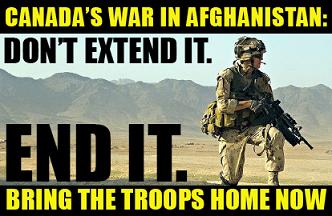
Regardless of the specifics of the mission, by staying in Afghanistan, Canada continues to enable a corrupt warlord led government that abuses the rights of the Afghan people. Canada and NATO have thus chosen to side with the drug warlords in a civil war in Afghanistan. How Canada chooses to support the warlords isn’t the issue.
Any foreign presence in Afghanistan is building up the resistance movements while simultaneously arming the various factions within the government. We are leaving a legacy of a divided and heavily armed state.
There are a series of problems with the strategy outlined by Minister MacKay. First, after almost a decade of training Afghan army and police forces they are still not able to provide basic functions of security. The notion that another two years of the same policies will alter this trajectory is foolhardy.
In fact, many of the police trained by the west join the resistance after their training is complete. For example, on November 1, in Ghazni Province an entire detachment of Afghan police burned their police station to the ground, stole the weapons and “defected” to the resistance movement. The U.S. Defense Department and the Inspector General for Reconstruction in Afghanistan admit that there are extremely high rates of desertion from the Afghan army with at least 25 per cent of new recruits defecting each year.
Also, the notion of a non-combat training mission is a farce. According to the Pentagon’s own figures there are high levels of resistance activity in 97 per cent of the country. If any Canadians remain as trainers, they will be in combat. General Rick Hillier, the former Canadian commander in Afghanistan has stated that there is no effective option for a non-combat role while training in Afghanistan.
This about face by the Conservatives is nothing new – in fact it is their preferred bait and switch tactic. In 2008, just before the debate that extended the mission to 2011, then Defence Minister Gordon O’Connor, was adamant that there would be no extension. “Our military commitment is, at the moment, to the end of February 2009,” he said. “I don’t know how many times I can say that, but I’ll keep saying it as long as they ask.”
The Prime Minister also stated that the mission would have to end in 2009. According to Canada.com:
“(W)hen asked whether he has any desire to prolong the combat mission in southern Afghanistan beyond 2009, Harper said: ‘No.’
“’I think Canadians are expecting that if we’re in Afghanistan after 2009, it would be a new mission,’ Harper told a Calgary radio talk show on Tuesday.
“’Canadians have been fairly clear that if we were to be in after 2009, that they would expect our participation to evolve in some way,’ Harper said.”
A majority of Canadians have said they want Canada out of Afghanistan. Once again, the Conservatives, with the help of the Federal Liberals are dismissing the opinions of the Canadian people. We need to make sure they hear us loud and clear. •
Canadian Peace Alliance, founded in 1985, is Canada’s largest umbrella peace organization.


